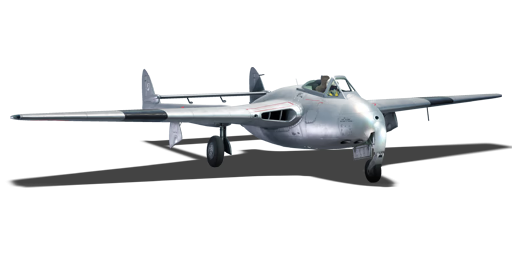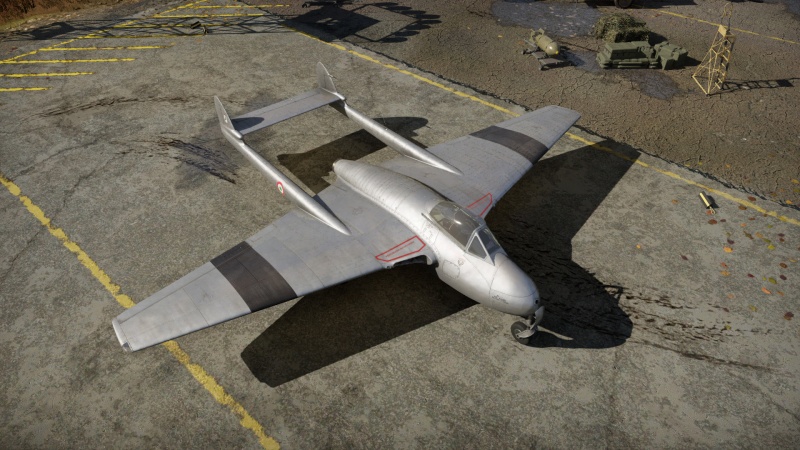Vampire FB 52A
| This page is about the Italian jet fighter Vampire FB 52A. For other versions, see Vampire FB 5 and J28B. |
Contents
Description
The Vampire FB 52A is a rank V Italian jet fighter with a battle rating of 7.7 (AB/SB) and 8.0 (RB). It was introduced in Update 1.91 "Night Vision". It is the first jet in the Italian tree's export fighter line, and is placed after the Re.2005 serie 0. It is followed by the rank VI fighter, the CL-13 Mk.4. The Vampire FB 52A is an export version of the British Vampire FB 6, itself an upgraded version of the Vampire FB 5 with an improved engine.
General info
Flight performance
The Vampire cannot reach the speeds a MiG-9 (l) or an F2H-2 can, it cannot accelerate as well as many of its counterparts, and it is appalling in a dive against most of its opponents. However, the Vampire has one impressive advantage against its jet-powered opponents: it can turn incredibly well. In fact, a good analogy to flying the Vampire is fighting jets in propeller aircraft.
| Characteristics | Max Speed (km/h at 4,572 m) |
Max altitude (metres) |
Turn time (seconds) |
Rate of climb (metres/second) |
Take-off run (metres) | |||
|---|---|---|---|---|---|---|---|---|
| AB | RB | AB | RB | AB | RB | |||
| Stock | 842 | 816 | 10668 | 24.8 | 25.6 | 16.6 | 15.5 | 650 |
| Upgraded | 917 | 882 | 23.8 | 24.0 | 26.0 | 21.0 | ||
Details
| Features | |||||
|---|---|---|---|---|---|
| Combat flaps | Take-off flaps | Landing flaps | Air brakes | Arrestor gear | Drogue chute |
| ✓ | ✓ | ✓ | ✓ | X | X |
| Limits | ||||||
|---|---|---|---|---|---|---|
| Wings (km/h) | Gear (km/h) | Flaps (km/h) | Max Static G | |||
| Combat | Take-off | Landing | + | - | ||
| 888 | 330 | 496 | 464 | 300 | ~10 | ~5 |
| Optimal velocities (km/h) | |||
|---|---|---|---|
| Ailerons | Rudder | Elevators | Radiator |
| < 550 | < 600 | < 600 | N/A |
Engine performance
| Engine | Aircraft mass | ||||||
|---|---|---|---|---|---|---|---|
| Engine name | Number | Empty mass | Wing loading (full fuel) | ||||
| de Havilland Goblin 3 | 1 | 3,385 kg | 191 kg/m2 | ||||
| Engine characteristics | Mass with fuel (no weapons load) | Max Takeoff Weight | |||||
| Weight (each) | Type | 11m fuel | 20m fuel | 30m fuel | 39m fuel | ||
| 705 kg | Centrifugal-flow turbojet | 3,754 kg | 4,034 kg | 4,345 kg | 4,625 kg | 5,606 kg | |
| Maximum engine thrust @ 0 m (RB / SB) | Thrust to weight ratio @ 0 m (100%) | ||||||
| Condition | 100% | WEP | 11m fuel | 20m fuel | 30m fuel | 39m fuel | MTOW |
| Stationary | 1,410 kgf | N/A | 0.38 | 0.35 | 0.32 | 0.30 | 0.25 |
| Optimal | 1,410 kgf (0 km/h) |
N/A | 0.38 | 0.35 | 0.32 | 0.30 | 0.25 |
Survivability and armour
- Armour Plates
- 38 mm Bulletproof glass in front of pilot.
- 12.7 mm Steel plate behind the pilot's head.
- 3 mm Steel plate below the engine.
The Vampire provides adequate protection to the pilot, as well as some armour under the engine. As with most jets, damage to the wings or fuselage greatly hampers flight performance, decreasing top speed and manoeuvrability. There are quite a few fuel tanks located in this plane's wings, so fuel fires may be common, especially when taking a high fuel loadout.
Modifications and economy
Armaments
Offensive armament
The Vampire FB 52A is armed with:
- 4 x 20 mm Hispano Mk.V cannons, chin-mounted (150 rpg = 600 total)
Suspended armament
The Vampire FB 52A can be outfitted with the following ordnance:
- Without load
- 2 x 1,000 lb G.P. Mk.I bombs (2,000 lb total)
- 8 x RP-3 rockets
Usage in battles
The Vampire is well-known for its ability to turn on a dime, but its incredible manoeuvrability also means that it has poor manoeuvring energy retention. Climbing is important for this plane, as is careful airspeed maintenance. When in a battle situation, it is advisable to always stay above 400 km/h; any slower, and the Vampire will greatly struggle to evade enemy fire.
If the Vampire is able to keep its energy, it becomes one of the best dogfighters at this rank. It can outturn nearly every other jet of its tier, and has a powerful engine to boot. Thanks to its great manoeuvrability, it is often quite easy to line up a shot against the enemy. One common tactic is to try luring the enemy into a turnfight. The Vampire will almost always come out on top. However, never commit to a dogfight if there are multiple enemies nearby. Turning will cause the Vampire's airspeed to fall dramatically, at which point enemies can easily swoop in and destroy it.
It is valuable to note that the Vampire has a low top speed for a jet, at only ~880 km/h. It also tends to compress as higher speeds. The Vampire may have difficulty in chasing down a faster enemy. Also note that firing the main cannon armament causes a downward recoil.
For attacking ground targets, the Vampire can be equipped with either bombs or rockets.
Pros and cons
Pros:
- Powerful armament
- Great manoeuvrability
- Decent payload options
- Good cockpit visibility
- Good at gliding without engine power
Cons:
- Low top speed and acceleration
- Weapon create significant recoil
- Poor dive rate
History
The de Havilland Vampire was an early British jet fighter. Its development began in 1941 and the design boasted several novel features. It was powered by a single turbojet engine in contrast to the twin engined Gloster Meteor due to the availability of more powerful engines; most production Vampires were powered by the Goblin engine, also manufactured by the de Havilland company. The twin-boom tail design allowed the fuselage to be kept short, reducing the length of the jet pipe and maximizing the amount of effective thrust by minimizing energy losses from friction. The air intakes were also located in the wing roots as opposed to directly in front of the engine. The fuselage was largely constructed of balsa wood as on the de Havilland Mosquito. While the Vampire first flew only months after the Meteor in 1943, it arrived too late to see combat in World War II. In Royal Air Force service, the initial Vampire F.1 variant replaced propeller fighters. Later fighter-bomber versions under the "FB" designation were capable of serving ground attack roles, leaving air defence to the better suited Meteor. While the Vampire was not an impressive jet aircraft in terms of speed, climb rate, or range, it was agile and easy to handle. It would ultimately equip 33 air forces over more than 30 years of service. The RAF retired the Vampire from combat roles in 1954 but retained the trainer variants until 1971. The design was developed further into the de Havilland Venom, which had a new engine and wing.
The Vampire FB.52 was an export version of the Vampire FB.6, which itself was sold to and license produced by Switzerland. Compared to the preceding FB.5, the FB.6 had a new Goblin 3 engine offering about 1.1 kN/112 kgf of extra thrust over the Goblin 2. The basic FB.52 was exported to Norway, New Zealand, and other operators. The Vampire FB.52A was a subvariant for Italy with minor differences. According to one source, the Italian Air Force received 51 FB.52As from Britain in 1950, and 195 subsequent aircraft were manufactured locally by Fiat and Macchi. Other sources differ on the production numbers. A considerable number of FB.52As were delivered by Italy to Egypt and possibly Syria from 1955-56.
The Vampire's service in Italian hands was uneventful. They were retired by 1960, being replaced by the F-84 Thunderjet and other aircraft. The Egyptian Air Force used its Vampires, largely consisting of FB.52s and FB.52As, in conflicts with Israel. Several were lost to Israeli Meteors and many were destroyed during the invasion of the Suez Canal in 1956. Afterwards, the Vampires were retired and replaced with Soviet aircraft.
Media
Skins:
- Skins for the Vampire FB 52A are available on WT Live.
Videos:
See also
- Vampire FB 5: An equivalent in the British tech tree
- J28B: An equivalent in the Swedish tech tree
External links
| De Havilland Aircraft Company Limited | |
|---|---|
| Fighters | Hornet Mk.I · Hornet Mk.III · Mosquito FB Mk VI · Mosquito FB Mk XVIII |
| Jet fighters | Vampire F.B.5 · Venom FB.4 · Sea Venom FAW 20 · Sea Vixen F.A.W. Mk.2 |
| Export | ␗Mosquito FB.Mk.26 · ▄Vampire FB 52A(Italy) · ▄Vampire FB 52A(Finland) · A28B |
| Italy jet aircraft | |
|---|---|
| Aerfer | Sagittario 2 · Ariete |
| Fiat | G.91 pre-serie · G.91 R/1 · G.91 R/4 (Portugal) · G.91 Y · G.91 YS |
| AMX International | AMX · AMX A-1A (Brazil) |
| Panavia | Tornado ADV · ▄Tornado IDS · ▄Tornado IDS (1995) |
| Foreign: | |
| Vampire | Vampire FB 52A |
| F-84 | ▄F-84F · ▄F-84G-21-RE |
| F-86 | CL-13 Mk.4 · ▄F-86K |
| F-104 | ▄F-104G · F-104S · ▄F-104S TAF (Turkey) · F-104S.ASA |
| F-16 | ▄F-16A ADF |
| AV-8 | ▄AV-8B Plus |
| Hungary | |
| Mikoyan-Gurevich | ◔MiG-15bis · ◔MiG-17PF · ◔MiG-21MF · ◔MiG-21bis-SAU · ◔MiG-23MF · ◔MiG-29 |
| Ilyushin | ◔IL-28 |
| Sukhoi | ◔Su-22M3 |
| Saab | ◔JAS39EBS HU C |





